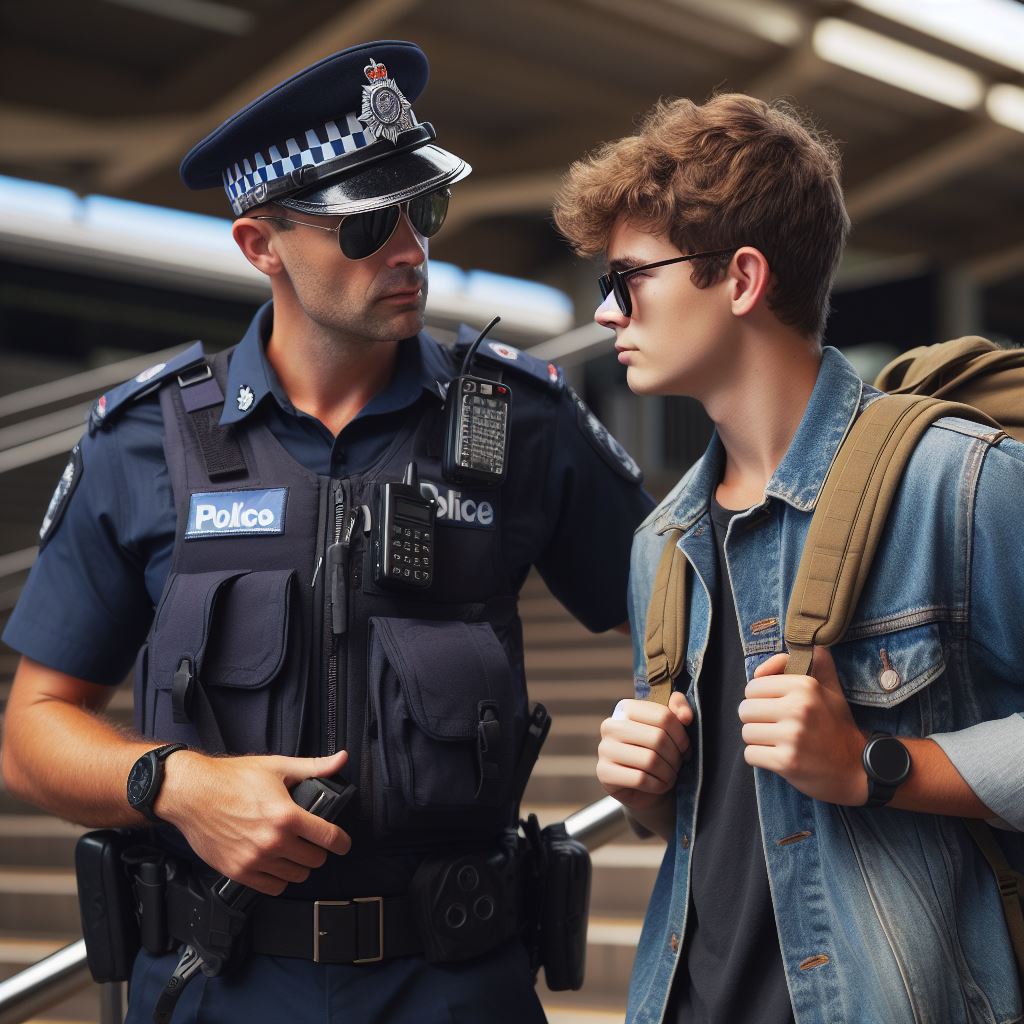Introduction
In the intricate fabric of societal dynamics, the symbiotic relationship between police and communities stands as a cornerstone for fostering safety, trust, and overall well-being.
This blog post embarks on a journey to unravel the profound importance of police and community relations, with a specific lens focused on the Australian context.
Effective police and community relations form the bedrock of a harmonious and secure society.
As active participants in ensuring public safety, law enforcement agencies must establish robust connections with the communities they serve.
This connection is more than a mere collaboration; it is a dynamic partnership that thrives on open communication, mutual respect, and a shared commitment to the welfare of the community.
Australia, as a diverse and multicultural nation, presents a unique canvas for examining the intricate interplay between law enforcement and the communities they protect.
This blog post hones in on the Australian experience, delving into the specific nuances, challenges, and successes that define police and community relations in this context.
Amidst the diverse landscapes, varying demographics, and distinct socio-cultural factors that characterize Australia, understanding the dynamics of police and community relations takes on heightened significance.
By shining a spotlight on the Australian narrative, we aim to contribute to the broader discourse surrounding effective policing strategies, community engagement initiatives, and the continuous pursuit of a safer, more cohesive society.
Join us in this exploration, where the significance of police and community relations takes center stage, and the focus narrows to the evolving landscape in the unique setting of Australia.
Historical Overview
The relationship between the Australian police and the community has had its share of ups and downs throughout history.
In the 19th century, the police force was primarily concerned with enforcing law and order and maintaining public safety.
However, their methods often lacked transparency and accountability.
One significant event that impacted the relationship was the Lambing Flat Riots in the 1860s, where tensions between Chinese gold prospectors and European miners escalated.
The police were accused of siding with the European miners, leading to a strained relationship with the Chinese community.
Another milestone was the establishment of the Commonwealth Police Force in 1917, which aimed to provide a cohesive policing approach across the newly formed Australia.
Despite this, there were instances of corruption and misconduct within the police force, which further damaged their relationship with the community.
The 1970s marked a turning point in police and community relations.
The Royal Commission into Aboriginal Deaths in Custody shed light on the mistreatment and deaths of Indigenous Australians while in police custody.
This sparked widespread protests and demands for police accountability and better treatment of marginalized communities.
Challenges or controversies faced in the past
Throughout the 20th century, multiple controversies further strained the relationship.
One such controversy was the 2004 Palm Island incident, where an Aboriginal man died in police custody, leading to allegations of police brutality and racial discrimination.
This incident highlighted the ongoing challenges faced by the police in building trust with the Aboriginal community.
The 21st century saw an increased emphasis on community policing and building positive relationships.
The National Cultural Competency Framework, introduced in 2011, aimed to promote understanding and respect between the police and diverse communities.
This framework recognized the importance of acknowledging cultural differences and incorporating community feedback into policing strategies.
Challenges still persist in police and community relations.
The issue of racial profiling remains a significant concern, with minority communities often feeling disproportionately targeted by police.
The 2019 Black Lives Matter protests further highlighted the need for police reform and addressing systemic biases.
The prevalence of social media has also had an impact on the relationship.
Incidents of alleged police misconduct can quickly go viral, leading to public outcry and a loss of trust in law enforcement.
However, social media has also provided a platform for police organizations to engage directly with the community and address concerns.
In general, the relationship between the Australian police and the community has evolved over time.
While there have been significant challenges and controversies in the past, efforts have been made to improve transparency, accountability, and cultural understanding.
Building trust and strong partnerships between the police and the community are vital for effective law enforcement and maintaining public safety.
Read: How to Become a Police Officer in Australia
Current State of Affairs
The current situation of police and community relations in Australia can be described as a mixed bag. While there are instances of positive interactions and collaboration, there are also several challenges and areas for improvement.
Challenges and Tensions
- There exist significant tensions between certain communities and the police force.
- Incidents of police misconduct and abuse of power have strained trust between the police and the community.
- Some minority groups face disproportionate targeting and discrimination by law enforcement.
- Cultural differences, language barriers, and lack of diversity within the police force contribute to misunderstandings.
Initiatives and Programs
To address these challenges and improve police and community relations, several initiatives and programs have been implemented:
- Community Police Liaison Officers have been appointed to foster better understanding and communication.
- The establishment of neighborhood watch programs encourages community members to actively participate in crime prevention.
- Police departments organize community engagement events like open days, workshops, and information sessions.
- Cultural awareness training programs have been introduced for law enforcement officers to promote inclusivity and sensitivity.
- Efforts are being made to increase the recruitment of individuals from diverse backgrounds into the police force.
Recent Incidents and Developments
Recent incidents and developments have had a profound impact on the police and community relations in Australia:
- The Black Lives Matter movement and protests worldwide have highlighted issues of systemic racism within law enforcement.
- The death of Aboriginal man David Dungay Jr. in custody prompted calls for justice and accountability.
- In 2020, a police officer was charged with murder over the shooting of an unarmed woman, further straining relations.
- The Royal Commission into Aboriginal Deaths in Custody has shed light on the disproportionate number of Indigenous Australians who die while in custody.
In light of these incidents and developments, the Australian government and police departments have acknowledged the need for comprehensive reform.
They are working towards implementing measures that promote transparency, accountability, and bridge the gap between the police and the community.
It is crucial for ongoing dialogue, cooperation, and mutual respect to be fostered between the police and the community.
Through genuine efforts to address concerns, build trust, and ensure equitable treatment, Australia can strive towards a future where police and community relations are strong and mutually beneficial.
Read: Day in the Life of an Aussie Police Officer
Factors Affecting Police and Community Relations
Building positive and trusting relationships between the police and the community is essential for maintaining law and order in any society. However, several key factors can influence the dynamic between these two entities:
Socioeconomic Factors
- Poverty, unemployment, and income inequality can create a sense of frustration and alienation within communities.
- These socioeconomic challenges may lead to increased criminal activities and strained relations with the police.
- Efforts to address these factors through community development and economic opportunities can foster better police-community relations.
Cultural Diversity
- A multicultural society brings together individuals from various cultural backgrounds.
- Differences in language, customs, and beliefs can create misunderstandings and mistrust between the police and communities.
- Police departments must promote cultural awareness and sensitivity among their officers to bridge these gaps and establish positive relationships.
Perceptions of Policing
- Community members’ perceptions of the police play a vital role in shaping their attitudes and interactions.
- Historical incidents of police misconduct or abuse can erode trust and generate negative perceptions of law enforcement agencies.
- Effective community policing strategies that prioritize accountability, transparency, and community engagement can help change these perceptions.
Media Coverage
- The media plays a significant role in shaping public opinion and perception of the police.
- Sensationalized or biased reporting can create a negative image of law enforcement agencies.
- Positive stories highlighting police-community collaboration and efforts to build trust can counterbalance negative portrayals.
Public Perception
- The overall beliefs and attitudes of the public towards law enforcement can impact police-community relations.
- Public trust and confidence in the police are crucial for effective crime prevention and community cooperation.
- Strengthening transparency, accountability, and communication channels can help improve public perception and enhance relations.
In fact, multiple factors contribute to the complex dynamic between the police and the community.
Addressing socioeconomic challenges, promoting cultural sensitivity, countering negative perceptions portrayed by the media, and fostering public trust are essential steps towards building a stronger and more cooperative relationship between the police and the community.
Read: Crisis Management in Diplomacy

Challenges and Issues
Building positive community relations is crucial for Australian police forces, but it is not without its challenges and issues.
In this section, we will identify and discuss common challenges faced by Australian police in their efforts to build positive community relations.
We will also address issues such as discrimination, racial profiling, and excessive use of force that can hinder this process. Furthermore, we will highlight any specific challenges unique to certain communities or regions.
Common Challenges Faced by Australian Police
- Limited resources: Police often face resource constraints, making it difficult to allocate sufficient time and personnel to community engagement.
- Lack of trust: Building trust with the community can be challenging, especially in areas where historical tensions between police and marginalized groups exist.
- Communication barriers: Language barriers or cultural differences can impede effective communication between police and certain communities.
- Negative perception: Some members of the community may hold negative perceptions of the police due to past experiences or media depictions.
- Resistance to change: Both the police force and the community may be resistant to change, making it challenging to implement new strategies for positive community relations.
Addressing Issues
Discrimination, racial profiling, and excessive use of force are critical issues that can undermine community trust. Australian police must address these issues head-on to build positive relationships with all members of society.
Your Personalized Career Strategy
Unlock your potential with tailored career consulting. Get clear, actionable steps designed for your success. Start now!
Get Started- Discrimination: Police must actively combat discrimination within their ranks and ensure fair treatment of all individuals regardless of their background.
- Racial profiling: Implementing strict policies against racial profiling and providing proper training to officers can help prevent the targeting of individuals based on race or ethnicity.
- Excessive use of force: Police should regularly review and update their protocols to emphasize de-escalation techniques and minimize the use of force whenever possible.
Challenges Unique to Certain Communities or Regions
Australia’s diverse communities face unique challenges that require tailored approaches to foster positive police-community relations.
- Indigenous communities: Historical injustices and cultural differences demand special attention to bridge the gap between Australian police and Indigenous communities.
- Migrant communities: Language barriers, fear of deportation, and cultural misunderstandings can heighten the challenges faced by police in building trust with migrant communities.
- Rural and remote areas: Limited resources, geographical constraints, and isolation can make it harder for police in rural and remote regions to engage effectively with their communities.
In summary, building positive community relations is an ongoing process that Australian police must navigate through various challenges and issues.
By addressing common challenges, such as limited resources and lack of trust, and tackling issues like discrimination and excessive use of force, the police can work towards fostering positive relationships with all communities.
Understanding and adapting to the unique challenges faced by Indigenous communities, migrant communities, and rural or remote areas is essential for effective community engagement.
Only through these efforts can Australian police make strides in creating safer and more connected communities.
Read: Diplomatic Immunity: The Basics
Learn More: Women in Firefighting: Breaking Barriers
Successful Strategies and Examples: Australian Police and Community Relations
In recent years, the Australian police force has made significant efforts to improve their relationship with the communities they serve.
By implementing successful initiatives and fostering trust, they have created a collaborative environment that benefits both the police and the community.
Community Policing Models and Partnerships
One successful community policing model is the Neighbourhood Watch program, which encourages residents to be vigilant and report any suspicious activities.
This partnership between the police and the community has proven effective in reducing crime rates.
Another example is the Youth Advisory Committees established in various cities.
These committees provide a platform for young people to engage with the police, voice their concerns, and work together to address issues affecting their communities.
This collaborative approach has resulted in improved relations between the police and the younger generation.
The Community Liaison Officer (CLO) program is yet another commendable initiative. CLOs are police officers assigned to specific neighborhoods, acting as a link between the police and the residents.
They actively engage with the community, attend local events, and address any concerns, helping to build trust and rapport.
Successful Initiatives and Best Practices
One exemplary initiative is the Victoria Police Multicultural Liaison Officers (MLO) program. MLOs are specially trained officers who understand cultural sensitivities and provide support and assistance to diverse communities.
This program has significantly improved the relations between the police and multicultural communities.
The Queensland Police Service has successfully implemented the “Coffee with a Cop” program.
This informal gathering allows community members to meet and interact with police officers in a relaxed setting, fostering positive relationships and reducing stereotypes.
The New South Wales Police Force has an innovative approach called the “My Local Police” initiative. Through this program, police officers actively engage with community members online, answering questions and addressing concerns.
This digital presence has increased trust and accessibility.
Programs Fostering Increased Trust and Collaboration
The Queensland Police Aboriginal and Torres Strait Islander Reference Groups play a pivotal role in enhancing police-community relations.
These groups provide a platform for Indigenous communities to voice their concerns, discuss cultural awareness, and work together to build stronger relationships.
The WA Police Force has implemented the “Blue Light” youth programs, which aim to engage young people in positive activities and promote understanding and trust between the police and the youth.
These programs have successfully reduced anti-social behavior and strengthened relations.
The South Australia Police have embraced restorative justice programs, such as “Circle Sentencing.
” This approach involves community members, offenders, and police officers coming together to discuss the impact of the crime and find resolutions that promote healing and reintegration.
In essence, the Australian police force has adopted various successful strategies and initiatives to improve their relationship with the community.
Through community policing models, partnerships, and programs, they have fostered trust, increased collaboration, and resulted in safer and more inclusive neighborhoods.
Continuous efforts in this direction are essential to maintain and strengthen these positive relations.
Benefits of Strong Police and Community Relations
In order to maintain a safe and secure society, it is crucial to have a positive relationship between the police force and the community they serve.
Such a relationship brings about numerous benefits that can have far-reaching effects on crime prevention, public safety, and community trust.
Improved Crime Prevention
- A strong bond between the police and the community promotes effective communication and information sharing.
- When the community feels comfortable with the police, they are more likely to report suspicious activities.
- Timely reporting of crimes leads to quicker responses from law enforcement, increasing the chances of catching offenders.
- By working together, both the police and the community can identify crime hotspots and implement preventive measures.
Increased Public Safety
- Positive police-community relations create an environment where people feel safe and protected.
- Residents are more likely to cooperate with law enforcement in crime investigations, leading to more arrests.
- When people trust the police, they are more willing to provide vital information for solving difficult cases.
- A sense of safety encourages community members to participate in neighborhood watch programs and crime prevention initiatives.
Enhanced Community Trust
- Building trust between the police and the community fosters a sense of mutual respect and understanding.
- Police officers who actively engage with the community are seen as approachable and caring individuals.
- As mutual trust grows, citizens become more willing to assist officers in maintaining law and order.
- Transparent and accountable policing practices help reinforce community trust in the justice system.
Impact on Willingness to Report Crimes and Cooperate with Law Enforcement
- Positive police-community relationships encourage individuals to trust in the system and come forward when crimes occur.
- When there is a lack of fear or intimidation, witnesses are more likely to testify in court proceedings.
- Victims of crimes will feel supported and protected, leading to increased willingness to seek justice.
- Cooperation between the community and law enforcement enhances the quality of investigations and ensures fair outcomes.
In a nutshell, strong police and community relations offer a multitude of benefits that contribute to a safer and more harmonious society.
The improved crime prevention, increased public safety, enhanced community trust, and willingness to report crimes all result from a positive and open relationship between the police and the community.
Recognizing the importance of these relations is essential for fostering a sense of security and cooperation within our communities.
Stand Out with a Resume That Gets Results
Your career is worth more than a generic template. Let us craft a resume and cover letter that showcase your unique strengths and help you secure that dream job.
Get HiredConclusion
Having strong police and community relations play a crucial role in ensuring a safe and harmonious society. It is evident that progress has been made in Australia, but challenges still persist.
The importance of trust, mutual respect, and effective communication cannot be emphasized enough in achieving a positive relationship between the police and the community.
We must continue to encourage ongoing efforts to foster a collaborative and cooperative environment, where both the police and the community work hand in hand.
By promoting transparency, community engagement, and accountability, we can ensure that the police are held responsible for their actions and decisions.
It is essential to address the remaining challenges, such as addressing unconscious bias, ensuring cultural diversity within the police force, and promoting equal treatment for all members of the community.
By doing so, we can create a society where everyone feels safe, supported, and valued. Collaborative problem-solving and community initiatives should be prioritized to build bridges and bridge gaps.
In closing, it is vital for both the police and the community to recognize the significance of a positive and cooperative relationship. Together, we can strive towards a society where trust, respect, and safety prevail.




